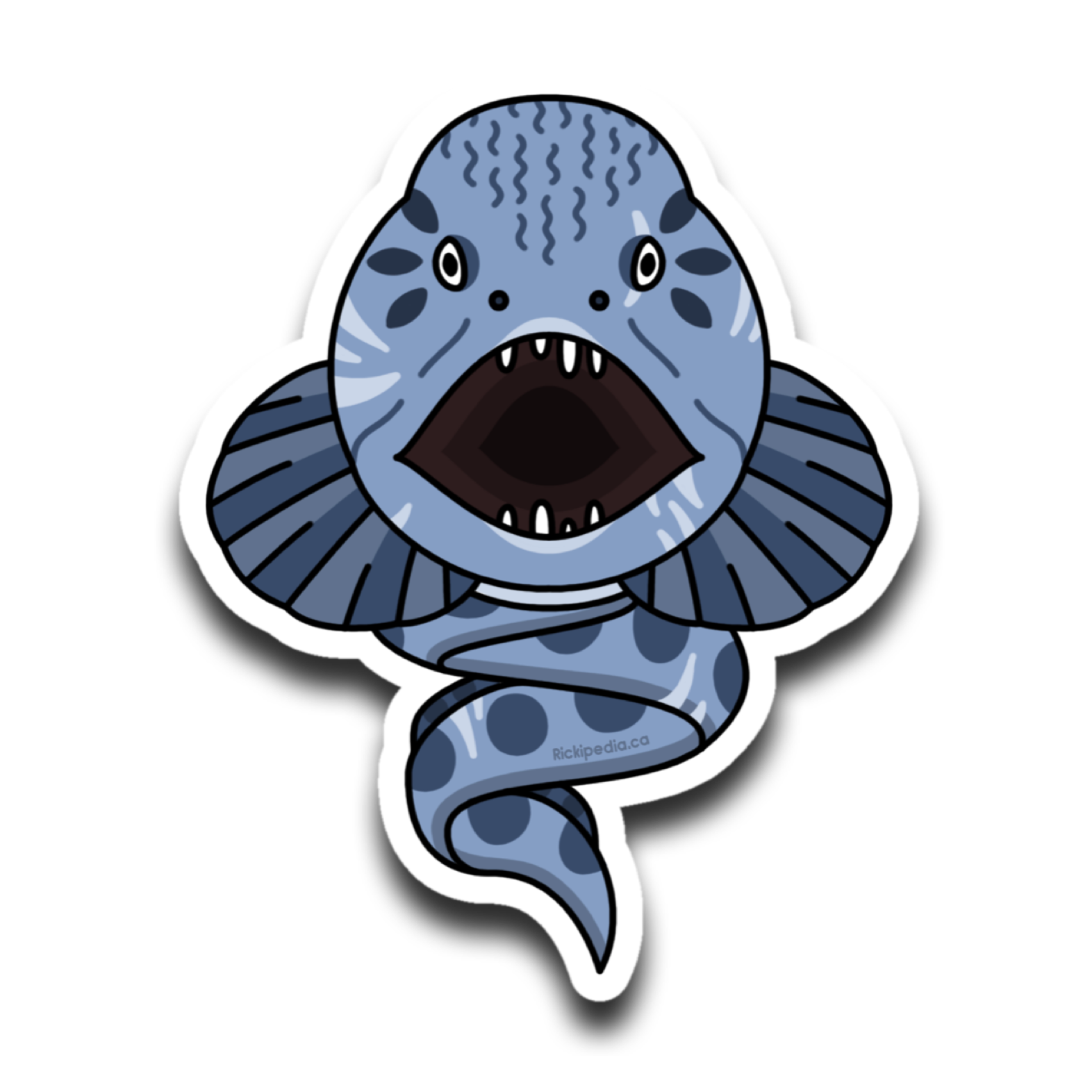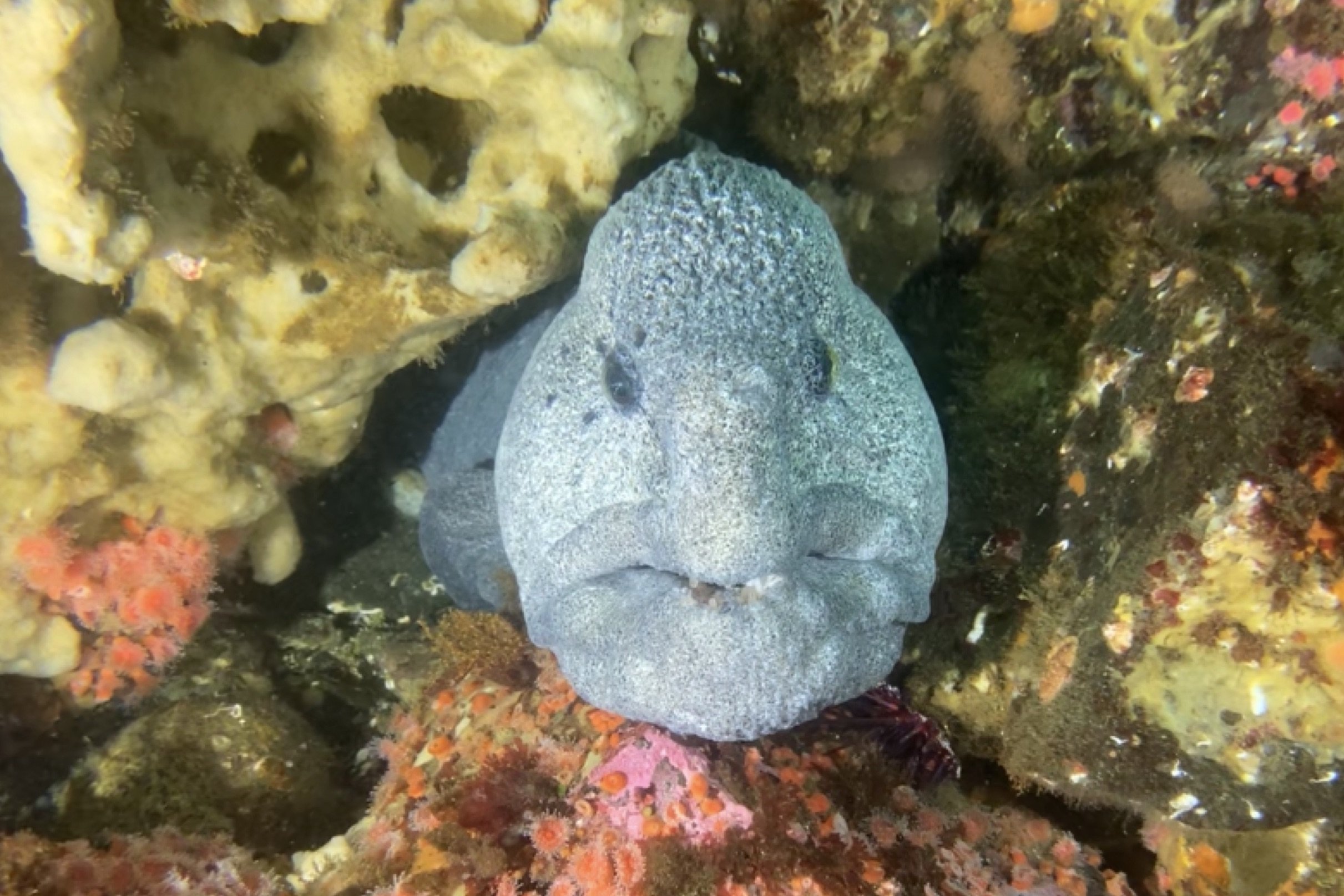Wolf Eel
Anarrhichthys ocellatus
Depending on who you’re speak to, people will use a range of colourful words to describe these incredible creatures. A fisher, whose encounters typically involve a struggle to deal with these creatures on the deck of a boat, may describe an angry, vicious beast with a jaw built only for mindless destruction. Talk to a scuba diver or naturalist, and you may get a kinder description, one of a powerful and stoic, yet curious and friendly creature.
This artwork is inspired by a still from a video I had taken of an adult male Wolf eel in the Discovery Passage:
September 2023: A large, well-known male Wolf eel curiously peers outside of its den. This individual has been living approximately 20 meters deep off of Grouse Island in the Discovery Passage for many years. Over time, they have grown quite curious of the divers who routinely come to visit.
📖 Description 📖
Despite its name, the Wolf eel isn’t actually a wolf. Some may find it less surprising to hear that this animal is not a type of eel either. They can be distinguished from True eels by the presence of pectoral fins found behind the gills on either side of the head. These fish belong to the same group as the gunnels and pricklebacks, who are also found in the Northeast Pacific but are far smaller and may appear less threatening to some.
Wolf eels often sport a golden-brown colour in their youth, presumably to blend in with the kelp forest habitat that they often shelter in. Most will shift to a grey or navy-blue complexion as they grow older and move to deeper, rockier habitats [1].
Like many fishes, Wolf eels have patterns on their faces that help them recognize one another. This is thought to be useful during territorial disputes and forming bonds or partnerships.
February 2016: A very shy juvenile Wolf eel peers out of its rocky crevice. At this age, they are quite vulnerable to predators. When escaping, the many spots on their dorsal fin can dazzle and confuse predators. Photographed of of Clover Point in Victoria, B.C.
🌎 Distribution 🌎
Like many well-known species in the Northeast Pacific, the Wolf eel has a much more vast distribution than one might initially think. These fish can be found almost anywhere between the Sea of Japan & the Sea of Okhotsk, all the way through the Aleutian Islands and down to the USA/Mexico border [2]. Within their distribution, Individuals can apparently travel great distances in search of suitable habitat. One Wolf eel was recorded travelling all the way from Northern Vancouver Island all the way down to Southern Washington [3]!
Distribution of the Wolf eel, Anarrhichthys ocellatus. Suitable habitat depicted in red.
🏝 Habitat 🏝
Living in rocky crevices for most of their lives, Wolf eels are considered a demersal fish, swimming off of the seafloor and into open waters only on very rare occasions. Unlike many fish, Wolf eels do not have a swim bladder and will naturally sink to the seafloor. There is no shortage of rocky habitat in the ocean however, and Wolf eels can be encountered anywhere from 1 meter beneath the surface all the way down to 226 meters deep [1].
Depth of suitable habitat for the Wolf eel, Anarrhichthys ocellatus. Suitable habitat depicted in red. Not to scale.
Wolf eels reside inside of rocky crevices known as dens, and much like octopuses, they spend a significant portion of their lives tucked safely inside. On rare occasions, Wolf eels and Giant pacific octopuses may fight each other over the ownership of these dens.
🦀 Diet 🦀
Wolf eels have a very interesting diet, which may explain their gnarled faces and jaws in adulthood. As youth, they choose to feed on softer foods such as small fishes and thin-shelled invertebrates. As they grow older, they gain an appetite for sea urchins. Other species that feed on sea urchins such as the Sea otter, are cunning and use rocks to crack open their urchins and scoop out the soft insides. Instead, wolf eels overcome their prey with their immensely powerful jaws, crushing their prey to death and swallowing the insides, shell, and sharp spines without much thought [1].
October 2017: A small, possibly female Wolf eel inspects my camera, likely trying to make sense of their own reflection in my lens. At this age, she has not yet developed the strong jaw necessary for crushing urchins, and likely resorts to a diet of crabs and small invertebrates. Photographed off of Ten Mile Point in Oak Bay, B.C.
🐟 Life Cycle 🐟
Among fishes, one could consider the Wolf eel to be a ‘romantic’ species. Male and female wolf eels have been recorded to spend as long as 7 years together in a single den. Spawning season typically takes place over the winter, during which the female will lay a cluster of eggs resembling a chunk of styrofoam. The pair take turns caring for the eggs, rotating the cluster to ensure all eggs get oxygen, and defending them from scavengers while the other hunts for food [.
While Wolf eel pairs may last long periods of time, many pairs have been seen to split up eventually and find new partners. As depicted below, domestic disputes are not unheard of, and may predict separations.
July 2018: A wolf eel pair on Quadra Island, consisting of a large grey male and a smaller, darker female welcoming some divers to their home.
July 2018: Soon after the above picture was taken, the male kindly demonstrated his frustrations for the onlooking divers.
📚 References 📚
[1] Monterey Bay Aquarium. (n.d.). Wolf-eel. Retrieved October 19th, 2023, from https://www.montereybayaquarium.org/animals/animals-a-to-z/wolf-eel
[2] Miller, D. (1982). Migration of a juvenile wolf eel, Anarrhichthys ocellatus, from Port Hardy, British Columbia, to Willapa Bay, Washington. Fishery Bulletin, 80(3).
[3] World Register of Marine Species. (n.d.). Anarrhichthys ocellatus (Ayres, 1855). Retrieved October 19th, 2023, from https://www.marinespecies.org/aphia.php?p=taxdetails&id=279605
[4] Marliave, J. (2007). The life history and captive reproduction of the Wolf‐eel Anarrhichthys ocellatus at the Vancouver Public Aquarium. International Zoo Yearbook, 26(1):70-81. 10.1111/j.1748-1090.1987.tb03138.x








